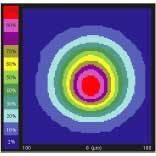Large mode area produces 500 W
The beam characteristics of a fiber laser are determined by the waveguiding properties of the fiber. Because these can be tailored by index profiling, fine beam shapes and precise focusing become possible, especially if single-mode fibers are used. In addition, fiber lasers profit from their large surface-to-volume ratio, which allows efficient cooling of the laser active medium. These properties allow scaling of fiber-laser emission power to levels that allow materials processing; such scaling is done by increasing the optical pump power and by lengthening the fiber. However, nonlinear effects such as stimulated Raman and Brillouin scattering and self-phase modulation can appear if the radiation intensity reaches a critical level in the fiber—effects that, to a degree, rise with increasing fiber length. On the other hand, using multimode fibers to combine individual single-mode fiber-laser outputs allows high continuous-wave (CW) power up to 2 kW, but deteriorates the beam quality (see Laser Focus World, December 2002, p. 11).
A group at the Friedrich-Schiller University, in cooperation with the Institut für Physikalische Hochtechnologie (both in Jena, Germany) recently achieved 500-W CW fiber-laser output at 1100 nm at a nearly diffraction-limited beam quality.1 The researchers overcame the problem of too high a radiation intensity in the fiber by choosing a low-numerical-aperture large-mode-area fiber. Such fibers show core diameters up to 30 µm and a reduced numerical aperture of about 0.06, thus expanding the fundamental mode to a larger cross section so that the power density is reduced by almost an order of magnitude for the same output power. Higher-order transverse modes can be efficiently suppressed by bending the fiber, thus introducing stronger losses for higher-order modes.
The fiber core of 24.5-µm diameter and numerical aperture of 0.086 was doped with neodymium ions (300 ppm Nd2O3) and codoped with ytterbium ions (650 ppm Yb2O3), making it possible to use three diodes at different wavelengths for simultaneous longitudinal optical pumping via the D-shaped cladding. For this purpose, a commercial laser-diode source was used that supplied 350 W at 976 nm, 175 W at 940 nm, and 175 W at 808 nm via a common 600-µm fiber and an imaging lens. A fiber length of 35 m was sufficient to absorb the pump light almost completely. Radiation at 808 nm is absorbed by the Nd ions, and at 940 and 976 nm by the Yb ions. Then the excitation of Nd is transferred to Yb, which radiates in the spectral range of 1020 to 1120 nm, depending on the fiber and resonator properties.
The cavity was formed by a broadband high-reflection mirror and the 4% Fresnel reflection at the fiber exit so that emission occurred in the spectral band of highest gain from about 1080 to 1110 nm (See Fig. 1). The output power vs. pumping power is a straight line up to 700-W pumping power, showing a slope efficiency of 72% and no indication of saturation. The beam profile is Gaussian-like even at full power, characterized by an M2-value of better than 1.5, and was not subjected to variation after switch-on of the laser and setting it to full power (see Fig. 2).
With a similar fiber design, the research group demonstrated an oscillator-fiber-amplifier system emitting nanosecond pulses with a pulse power of up to 4 mJ at a repetition rate of 3 kHz and an average power of up to 100 W at a pulse energy of 2 mJ.2 In a high-power fiber chirped-pulse-amplification system, an average output power of 145 W at a repetition rate of 75 MHz was reached at the output of a large-mode-area fiber amplifier. The pulses were recompressed down to 400 fs applying a transmission grating compressor. The average power after the compressor was 76 W.3
REFERENCES
- J. Limpert, A. Liem, H. Zellmer, A. Tünnermann, Elect. Lett. 39(8) 645 (2003).
- J. Limpert et al., Appl. Physics B 75, 477 (2002).
- J. Limpert et al., accepted for publication in Optics Lett.


